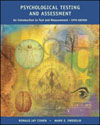 |
1 |  | 
Why measure personality? |
|  | |
 |
 |
2 |  | 
Compare and contrast with specific examples the terms: personality traits, states, and types. Which term do you believe is most useful for behavioral description? Discuss the relevance of the concept of situation-dependency with respect to these terms. |
|  | |
 |
 |
3 |  | 
Discuss why personality assessment is or is not necessary and/or important. In what settings and for what purposes is personality assessment useful? |
|  | |
 |
 |
4 |  | 
If you were a test author, why might you want low test-retest reliability for a test that measures a state and high test-retest reliability for a test that measures a trait? |
|  | |
 |
 |
5 |  | 
What are the advantages and limitations of the various methods of constructing personality tests by (a) logical or content test construction, (b) factor-analytic methods, (c) empirical criterion keying approach, and (d) theoretical approach? |
|  | |
 |
 |
6 |  | 
If you were being considered for a job as a personnel psychologist, would you hope that your prospective employer was clinical or actuarial in his/her approach to evaluation? What if you were undergoing counseling in the university counseling center–which approach would you hope the staff practiced? |
|  | |
 |
 |
7 |  | 
What are the problems inherent in rating scales for use in personality assessment? |
|  | |
 |
 |
8 |  | 
Give examples from your own experience that relate to efforts of impression management
in your own life (e.g. job interviews, first dates). How does this concept relate to personality assessment? |
|  | |
 |
 |
9 |  | 
Give examples of your experience with rating scales. What impact might the halo effect, leniency or generosity, severity, or errors of central tendency have had on your ratings? |
|  | |
 |
 |
10 |  | 
How do self-report personality inventories such as the MMPI-2 attempt to reduce the possibility of "faking" (i.e., use of various "validity scales")? How critical is this potential problem with self-report measures? Discuss the arguments pro and con for the use of validity scales. Discuss other methods to determine the accuracy of self-report information and include in your discussion the various methods to guard against rater error and bias when using informants. |
|  | |
 |
 |
11 |  | 
Compare and contrast the criteria used in determining what makes a good personality test and those used in determining what makes a good intelligence or achievement test. |
|  | |
 |
 |
12 |  | 
Compare and contrast the MMPI and the MMPI-2 and MMPI-2 and the MMPI-A. What characteristics of the MMPI contributed to the decision to revise it and extend it downward? What has contributed to its popularity as the world's most widely used and widely researched psychological test? What questions remain about the use of both tests for clinical practice? For research? |
|  | |
 |
 |
13 |  | 
How are instruments used in personality testing that are "theory saturated" different from those that are relatively atheoretical? Provide some examples of each. Which would you prefer to use if you were a psychologist assessing the personality of your client? |
|  | |
 |
 |
14 |  | 
For reliable and valid results to be yielded from a personality assessment is it necessary for the assessors to have "cultural competence"? Is this realistic to expect? In what cultures would you be deemed competent? What criteria should be used to determine if one has attained "cultural competence"? What are the reactions to the authors of your text definition of "culturally sensitive psychological assessment"? |
|  | |
 |
 |
15 |  | 
Review the different types of personality assessment questions in Figure 11-1. Which item types are you most comfortable with? |
|  | |
 |
 |
16 |  | 
Which area(s) of psychological assessment (cognitive/intelligence, personality, academic achievement) are most susceptible to the influence of culture? |
|  | |
 |
 |
17 |  | 
Discuss the various ways in which language can impact personality assessment. |
|  | |
 |
 |
18 |  | 
In light of the increased violence occurring in elementary and secondary schools, discuss the use of measures such as the Aggression Questionnaire (see Figure 11-1) to predict violence in school settings. Discuss the arguments for and against the use of such measures as screening measures to identify potentially violent students. |
|  | |
 |



 2002 McGraw-Hill Higher Education
2002 McGraw-Hill Higher Education